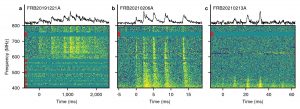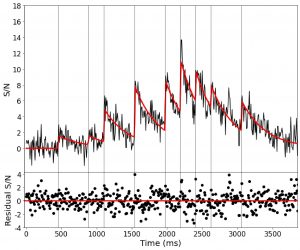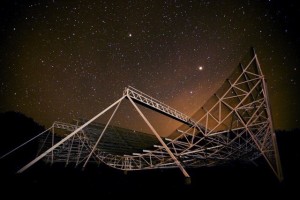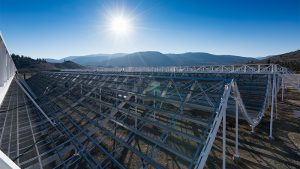The clear and periodic pattern of fast radio bursts may originate from a distant neutron star.
By Jennifer Chu (MIT News Office), with notes from Meaghan MacSween
Along with collaboration partners, astronomers at the Dunlap Institute and the David A. Dunlap Department of Astronomy and Astrophysics have detected a strange and persistent radio signal from a far-off galaxy, that appears to be flashing with surprising regularity.
The signal is classified as a fast radio burst, or FRB — an intensely strong burst of radio waves of unknown astrophysical origin, that typically lasts for a few milliseconds at most. However, this new signal persists for up to three seconds, about 1,000 times longer than the average FRB. Within this window, the team detected bursts of radio waves that repeat every 0.2 seconds in a clear periodic pattern, similar to a beating heart.
The researchers have labeled the signal FRB 20191221A, and it is currently the longest-lasting FRB, with the clearest periodic pattern, detected to date.
The source of the signal lies in a distant galaxy, several billion light-years from Earth. Exactly what that source might be remains a mystery, though astronomers suspect the signal could emanate from either a radio pulsar or a magnetar, both of which are types of neutron stars — extremely dense, rapidly spinning collapsed cores of giant stars.

Only three fast radio bursts from CHIME/FRB seem to show this periodic signature, shown here all together. At the top of each plot is the total signal measured by CHIME/FRB, with the full frequency resolution for each FRB shown below. While the periodicity from FRB20191221A (left) is statistically significant, two other FRB sources, FRB20210206A (middle) and FRB20210213A (right), also show potential periodicity. Credit: The CHIME Collaboration.
“There are not many things in the universe that emit strictly periodic signals,” says Daniele Michilli, a postdoc in MIT’s Kavli Institute for Astrophysics and Space Research. “Examples that we know of in our own galaxy are radio pulsars and magnetars, which rotate and produce a beamed emission similar to a lighthouse. And we think this new signal could be a magnetar or pulsar on steroids.”
“We have been observing periodic signals from neutron stars in the Milky Way for decades and it’s likely that this signal originates from a neutron star as well,” agrees Dunlap Fellow Ziggy Pleunis, “because we don’t know of other objects producing periodic signals on these short timescales.”
The team hopes to detect more periodic signals from this source, which could then be used as an astrophysical clock. For instance, the frequency of the bursts, and how they change as the source moves away from Earth, could be used to measure the rate at which the universe is expanding.
The discovery is reported today in the journal Nature, and is authored by members of the CHIME/FRB Collaboration, including Dunlap/U of T Co-Authors: Daniela Breitman, Tomas Cassanelli, Bryan Gaensler, Ryan Mckinven, Cherry Ng, Chitrang Patel, Ue-Li Pen, Ziggy Pleunis, Andre Renard, Paul Scholz, and Keith Vanderlinde.
Since the first FRB was discovered in 2007, hundreds of similar radio flashes have been detected across the universe, most recently by the Canadian Hydrogen Intensity Mapping Experiment, or CHIME, an interferometric radio telescope consisting of four large parabolic reflectors that is located at the Dominion Radio Astrophysical Observatory in British Columbia, Canada.
CHIME continuously observes the sky as the Earth rotates, and is designed to pick up radio waves emitted by hydrogen in the very earliest stages of the universe. The telescope also happens to be sensitive to fast radio bursts, and since it began observing the sky in 2018, CHIME has detected hundreds of FRBs emanating from different parts of the sky.

The “heartbeat” of FRB 20191221A. Over about 3 seconds, this single pulse from a fast radio burst showed highly periodic sub-bursts shown here in black with a red line fitting the data. The FRB source beats every 0.2 seconds with each beat marked here by a vertical line. Credit: The CHIME Collaboration.
The vast majority of FRBs observed to date are one-offs — ultrabright bursts of radio waves that last for a few milliseconds before blinking off. Recently, researchers discovered the first periodic FRB that appeared to emit a regular pattern of radio waves. This signal consisted of a four-day window of random bursts that then repeated every 16 days. This 16-day cycle indicated a periodic pattern of activity, though the signal of the actual radio bursts was random rather than periodic.
On Dec. 21, 2019, CHIME picked up a signal of a potential FRB, which immediately drew the attention of the collaboration.
“This burst immediately looked different than the FRBs we’re used to detecting with CHIME,” says Dunlap Fellow Paul Scholz. “We were very excited upon seeing it, as it was clear from the length of the burst and the clear periodic peaks, that we were detecting something new.”
In analyzing the pattern of FRB 20191221A’s radio bursts, the CHIME Collaboration found similarities with emissions from radio pulsars and magnetars in our own galaxy. Radio pulsars are neutron stars that emit beams of radio waves, appearing to pulse as the star rotates, while a similar emission is produced by magnetars due to their extreme magnetic fields.
The main difference between the new signal and radio emissions from our own galactic pulsars and magnetars is that FRB 20191221A appears to be more than a million times brighter.
Michilli says the luminous flashes may originate from a distant radio pulsar or magnetar that is normally less bright as it rotates and for some unknown reason ejected a train of brilliant bursts, in a rare three-second window that CHIME was luckily positioned to catch.
“CHIME has now detected many FRBs with different properties,” Michilli says. “We’ve seen some that live inside clouds that are very turbulent, while others look like they’re in clean environments. From the properties of this new signal, we can say that around this source, there’s a cloud of plasma that must be extremely turbulent.”
“By comparing the properties of this newly discovered signal with those of already known FRBs we can see if they all have common origins or if there might be multiple ways of producing FRBs,” Pleunis adds.
The astronomers hope to catch additional bursts from the periodic FRB 20191221A, which can help to refine their understanding of its source, and of neutron stars in general.
“Compared to the short FRBs that we are used to, these events are quite rare,” explains Scholz. “This event thus shows the discovery potential of telescopes like CHIME that can scan the sky quickly. CHIME and future telescopes will be sure to find more of these gems that point to potentially different origins from the bulk of FRBs.”
This research was supported in part by the Canada Foundation for Innovation.
________________________________________________________________________________________
For more information, contact:
Meaghan MacSween
Communications Officer, Dunlap Institute for Astronomy & Astrophysics
University of Toronto
meaghan.macsween@utoronto.ca
The Dunlap Institute for Astronomy and Astrophysics at the University of Toronto is an endowed research institute with over 80 faculty, postdocs, students, and staff, dedicated to innovative technology, groundbreaking research, world-class training, and public engagement.
The research themes of its faculty and Dunlap Fellows span the Universe and include: optical, infrared and radio instrumentation, Dark Energy, large-scale structure, the Cosmic Microwave Background, the interstellar medium, galaxy evolution, cosmic magnetism and time-domain science.
The Dunlap Institute, the David A. Dunlap of Astronomy and Astrophysics, and other researchers across the University of Toronto’s three campuses together comprise the leading concentration of astronomers in Canada, at the leading research university in the country.
The Dunlap Institute is committed to making its science, training, and public outreach activities productive and enjoyable for everyone of all backgrounds and identities.


